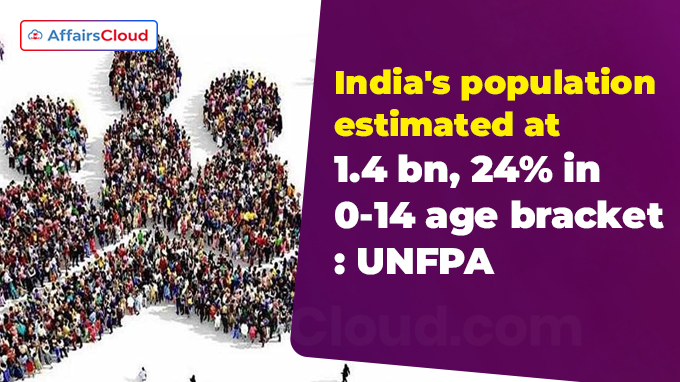
According to the report released by the United Nations Population Fund’s (UNFPA) State of the World Population, titled “Interwoven Lives, Threads of Hope: Ending Inequalities in Sexual and Reproductive Health and Rights“.
- The report revealed that India’s population is estimated to double in 77 years.
- The report also stated that India is the global leader in terms of the population with an estimated population of 1.44 billion ahead of China at 1.425 billion.
- The last consensus that was conducted in 2011 recorded India’s population at 1.21 billion.
Key Highlights of the Indian population:
i.The UNFPA report highlighted that an estimated 24% of India’s population is aged 0-14 while 17% lies within the range of 10-19 years.
ii.The 10-24 years age segment is estimated to constitute 26%, with the 15-64 age group comprising of 68%.
iii.Moreover, 7% of India’s population is aged 65 years and above, with men having a life expectancy of 71 years and women 74 years.
iv.The most marginalised communities worldwide have been ignored despite 30 years of progress in sexual and reproductive health.
v.It also stated the child marriage percentage (by age 18) in India was at 23 between 2006-2023.
Health Specific findings by the report:
i.The report showed that the maternal deaths in India have fallen significantly, accounting for 8% of all such mortalities worldwide.
ii.India’s success is often the result of improved access to affordable, quality maternal health services as well as efforts to address the impact of gender discrimination on health outcomes but still there are loopholes when it comes to maternal health risk.
iii.In relation to the report on “Estimates and Correlates of District-Level Maternal Mortality Ratio in India” by Public Library of Science (PLOS) Global Public Health, UNFPA highlighted that 640 districts in India have achieved the sustainable development goal of reducing maternal mortality ratio below 70 per 100,000 live births but still 114 districts have ratios of 210 or more.
iv.The highest ratio of maternal mortality was seen in Tirap district of Arunachal Pradesh, a rural area with a high proportion of indigenous peoples (1,671 per 100,000 births).
v.The report showed that the women with disabilities tend to experience 10 times more gender-based violence than their peers without disabilities.
- Women and girls with disabilities, migrants and refugees, ethnic minorities, LGBTQIA+ people, people living with HIV and disadvantaged castes face greater sexual and reproductive health risks and also unequal access to sexual and reproductive health care. This is enhanced by climate change, humanitarian crises and mass migration.
vi.On the other hand, better healthcare access has mostly helped rich women and people from ethnic groups who already had good access to healthcare.
Global Outcomes of the report:
i.The report said that 800 women die every day giving birth, unchanged since 2016.
ii.The women’s bodily independence to take decisions is diminishing shown by the 40% of countries with data.
Despite all the challenges, UNFPA has tried to reduce the unintended pregnancy rate by nearly one-fifth, lowered the maternal death rate by one-third, and secured laws against domestic violence in more than 160 countries.
About United Nations Population Fund (UNFPA):
UNFPA has been operating in India since 1974.
Executive Director – Natalia Kanem
Headquarters – New York, United States
Founded – 1969